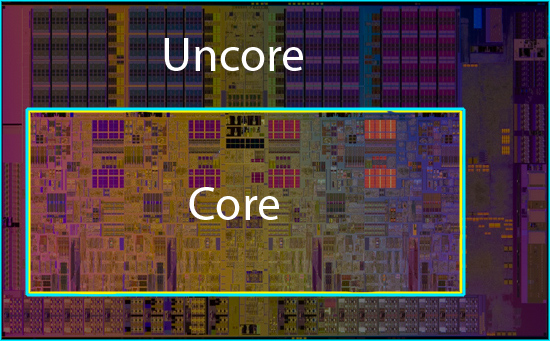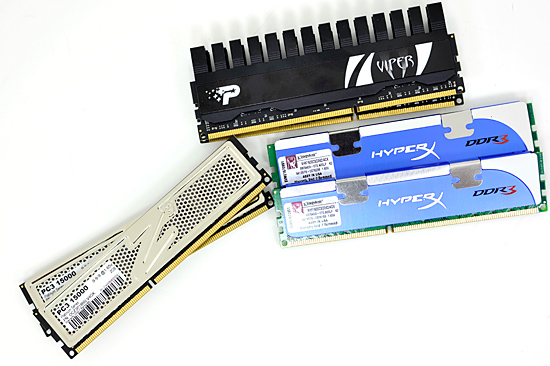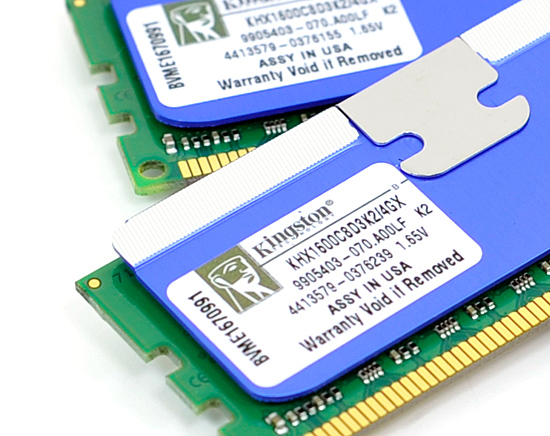Intel's Core i7 870 & i5 750, Lynnfield: Harder, Better, Faster Stronger
by Anand Lal Shimpi on September 8, 2009 12:00 AM EST- Posted in
- CPUs
Lynnfield's Un-Core: Faster Than Most Bloomfields
A few years ago I had a bet going with AMD's Ian McNaughton. We were at an AMD event where the Phenom architecture was first being introduced and he insisted that the L3 cache was part of the memory controller. This didn't make any sense to me so I disagreed. Minutes later a presentation slide went up on a projector talking about how the L3 cache and memory controller were on the same voltage plane; that's what he meant. Ian laughed a lot and to this day he holds it over my head.
The moral of the story is in Phenom and later in Nehalem, the processor is divided into two parts. Intel named them the core and the un-core. The "core" of these multi-core processors is made up of each individual processor core and its associated private caches (L1/L2). The "uncore" refers to everything else: PCIe controller, memory controller, DMI/QPI and the L3 cache.

The uncore isn't as critical for performance but is made up of a ton of transistors; roughly 400 million in the case of Lynnfield/Bloomfield (more if you count the PCIe controller). In order to save power, Intel uses slower transistors that have lower leakage for the un-core. As a result, the un-core can't clock up as high as the core and runs at a lower multiplier.
Take the Bloomfield Core i7 975 for example. The core runs at 25x BCLK (25 x 133MHz = 3.33GHz), but the un-core runs at 20x BCLK (20 x 133MHz = 2.66GHz). The rest of the chips, including Lynnfield, have slower un-cores:
| CPU | Socket | Core Clock | Un-Core Clock |
| Intel Core i7 975 Extreme | LGA-1366 | 3.33GHz | 2.66GHz |
| Intel Core i7 965 Extreme | LGA-1366 | 3.20GHz | 2.66GHz |
| Intel Core i7 950 | LGA-1366 | 3.06GHz | 2.13GHz |
| Intel Core i7 940 | LGA-1366 | 2.93GHz | 2.13GHz |
| Intel Core i7 920 | LGA-1366 | 2.66GHz | 2.13GHz |
| Intel Core i7 870 | LGA-1156 | 2.93GHz | 2.40GHz |
| Intel Core i7 860 | LGA-1156 | 2.80GHz | 2.40GHz |
| Intel Core i5 750 | LGA-1156 | 2.66GHz | 2.13GHz |
Here's another area where Lynnfield is better than the lower end Bloomfields: its uncore runs at 2.40GHz instead of 2.13GHz. The exception being the Core i5 750, its uncore is stuck at 2.13GHz as well. Once again, only the "Extreme" Bloomfields have a faster uncore.
Lynnfield's Memory Controller: Also Faster than Bloomfield
Intel only officially supports two memory speeds on Bloomfield: DDR3-800 and DDR3-1066. Obviously we're able to run it much faster than that, but this is what's officially validated and supported on the processors.
Lynnfield is a year newer and thus gets a tweaked memory controller. The result? Official DDR3-1333 support.

Three Lynnfield memory kits (left to right): OCZ, Patriot and Kingston
The same sort of rules apply to Lynnfield memory kits that we saw with Bloomfield. You don't want to go above 1.65V and thus all the kits we've seen run at 1.5V for the stock JEDEC speeds or 1.65V for the overclocked modules.

Like Bloomfield, 1.65V is the max we'll see on Lynnfield










343 Comments
View All Comments
Ann3x - Wednesday, September 9, 2009 - link
1/ There is no chance that any of these chip can run safely with no fan.2/ You dont get huge temperature increases if you dont overvolt, just clock changes result in very small temperature changes. look at the article you linked. The 3 new chips use EXACTLY the same power despite their differing clock speeds.
3/ New energy saving technology works with overclock just like it does with stock clock ed CPUs (eg energy states, my i7 is overclocked to 4ghz on stock volts, when its not needed it clock down - same end effect as these new chips (albeit slightly less elegant)).
This whole fuss about turbo mode is just marketing gumph and yet people are totally sucked in by the hype.
coconutboy - Wednesday, September 9, 2009 - link
1- I never said anything about running the CPU w/o a fan. Fanless watercooling is an option, as is quiet low rpm fans.2- Clocking w/o increasing voltage does increase heat and whether or not you consider that to be a significant amount depends on the cooling solution you use. I made no claim that OC'd temps would increase as much as overvolting.
Your opinion about the validity of turbo mode is just that, you opinion. You and I can agree to disagree.
titanium001 - Wednesday, September 9, 2009 - link
I was excited to see the article, but was left wondering and scratching my head when gaming performance was evaluated. I didn't see any 1920 x 1200 or 2560 x 1600 comparisons anywhere. Do the i7 800 series take a significant performance hit in these settings. I guess everything can't be delivered until a full in depth review. Have to just wait. I'll reserve my judgment about the 800 series until then, for now, it's just another proc. Thanks for the initial preview Anandtech.com.Anand Lal Shimpi - Wednesday, September 9, 2009 - link
Have a look at the SLI/CF Multi-GPU Gaming page, I include some GPU limited tests at the bottom of that page.At higher resolutions P55, X58 and even Phenom II/790FX all perform the same if you're GPU limited. The PCIe limitations of P55/Lynnfield only come into play when you're running in multi-GPU mode because the x16 interface gets broken up into a pair of x8s.
Take care,
Anand
NoobyDoo - Tuesday, September 8, 2009 - link
... remember when C2D was released ?coconutboy - Tuesday, September 8, 2009 - link
After thoroughly reading a lot of the articles at Toms, Anand, xbit etc, Lynnfield looks great and has been worth the wait. However, it's not an absolute sell as a gamer box IMO. My g/f and I have been waiting to build a pair of new gaming computers, but wanted to see what i5 had to offer first. Now that NDAs are down, the $30-70 savings for p55 versus comparable x58 mobos is great, but some things about i5 still make me want an i7 920 instead.My g/f and I plan on buying a pair of GTX 275s, one for each computer. Then later on as our systems age, we'll put both 275s in one box and buy a newer vid card for the other system. We also moderately overclock our CPUs (3.2-3.4 would be what I expect for a i7 920) to boost performance w/o shortening the lifespan too much because our gamer boxes usually end up moving down the line in our home network to become servers or some such.
Taking into account everything I've been reading at hardware sites thus far, we'll likely build one Lynnfield and one i7 for our gaming rigs. I expect one of the current gamer computers we build will migrate to become a VMware machine later on which means an i7 920 w/ (eventually) 24GBs of RAM is very attractive. The ability to use a 6 core CPU later on counts for a lot as well.
coconutboy - Wednesday, September 9, 2009 - link
edit- I meant to be comparing an mildly overclocked i7 920 @ stock voltage and 3.3-3.4GHz versus an i7 860/870, not an i5. I'd often prefer the 920 (but not always of course) for my uses.thebeastie - Tuesday, September 8, 2009 - link
Such a good complete review, EXCEPT there is no information of how much power the CPU used with it was hard overclocked to its 4.2Ghz mark.With its intergrated PCIe 100million transistor count controller inside the CPU this would of been really interesting info.
Gary Key - Wednesday, September 9, 2009 - link
The system power utilized (measured at the wall) was 301W for the 4.2GHz overclock on the 870 under an eight thread 100% load test on the board.justme2009 - Tuesday, September 8, 2009 - link
Why are you overhyping this garbage? I'm waiting for Clarkdale. I'm still ticked off that Intel caved to the manufacturers and held off on releasing it, we were supposed to have it in the 4th quarter of this year, now it will be first half of 2010.This new nehalem (even if it's for desktops) will be nothing compared to the mobile nehalem next year.
My only other question is, why the hell has Clarkdale/Arrendale information been buried? There hasn't been a peep from anyone about it since February.